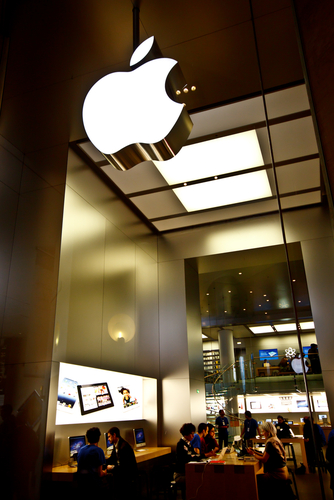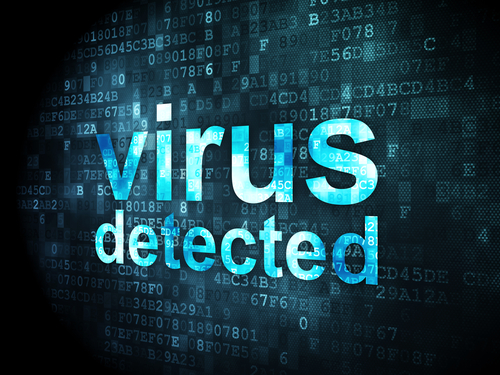December 18th, 2013

In humans, early detection is important for treating viruses and other infections. The same goes for computers. Malware, viruses and other threats that infiltrate your system become more damaging the longer it takes to discover them. A post at Rediff points to some signs all computer users should look for that suggest your computer has been infected.
Email addresses are often hacked, but the good news is that it’s usually easy to tell when something’s wrong. Make a habit to check your sent messages and make sure they’re all emails you sent personally. If you have sent messages you don’t recognize, it’s likely that someone else has access to your account. If you’ve received a message from a contact that looks like spam, be sure to tell them that their email may have been compromised.
Most hackers will try to hide their actions, but some malware will still alter the look of your computer’s desktop. If your wallpaper has changed, or there are new icons you don’t recognize, there’s probably malware hiding somewhere on your system.
Malware has the ability to change your passwords, prevent you from accessing Windows tools like Control Panel and Task Manager and lock you out of your computer completely. If you notice your system performing strangely, even if it’s just slower than usual, it’s important to act quickly. Otherwise, you may find that you’ve lost control of your machine completely.
Malware infects computers in a variety of ways. Most commonly, it’s downloaded when a user opens a bad email attachment, or clicks on a bad link. Visiting untrusted websites and downloading programs from untrusted sources are also ways that malware can infect you.
There are two steps to avoiding malware. First, secure your computer. Install an antivirus program and use a secured network with a firewall in place. Then, be careful when surfing the web. Avoid potentially dangerous situations that could lead to a malware infection.
If your computer is infected by malware, bring it to Geek Rescue or call us at 918-369-4335. We’ll remove any harmful files and help you protect against future attacks.
December 18th, 2013

The number of smartphone users worldwide is continually growing. The way they use their devices is also expanding with more internet browsing and online activity than ever before. Unfortunately, this means that smartphone users are becoming a more valuable target for hackers and malware. Protecting your mobile device with antivirus or anti-malware apps is important, but as Mathew J. Schwartz reports for Information Week, even the best antivirus apps available to Android users can’t remove malware from your phone.
That may sound like an odd statement but Android antivirus apps can’t delete or even quarantine threats they detect. The reason for this limitation is Google’s Android Application Sandbox. Every Android app runs in this sandbox, which isolates app data and code execution from other apps on the device. With each app isolated, an antivirus app doesn’t have the permissions needed to delete malware it finds.
Security apps are getting better for Android, however. Researchers testing 28 different security tools for Android found that their average success rate improved in the past three months, from 90.5-percent to 96.6-percent. They found that the best apps come from familiar names like Avast, Symantec, Avira and Kaspersky.
When choosing a security app, there’s more to consider than just if it can detect malware. You want an app that doesn’t overly drain your battery and one that loads quickly and runs efficiently. You also have to consider how accurate its detection rate is. You don’t want false positives going off each time you attempt to install a clean app.
Despite the improvements being made to Android security apps, they’re going to continue to be lacking until they’re allowed to actively treat the malware infections they detect. Google has remained silent on when that might be.
In the meantime, users must be in charge of their own security. When using your smartphone, you can’t rely on security precautions to keep you safe. Instead, you’ll need to steer clear of malware by avoiding suspicious links and untrusted malware. Understand that your device isn’t secure and don’t visit potentially dangerous websites.
If you have a malware infection on any of your devices, including your smartphone, bring it to Geek Rescue or call us at 918-369-4335. We remove malware, viruses and fix any issue you’re having.
December 17th, 2013

For business and even personal use, the cloud is earning the trust of more and more users. But, privacy and security remain major concerns. Victoria Ivey of CIO published a list of ways to maintain better security with the cloud, which mostly involve more diligence from users.
There are a seemingly endless number of options for how to use the cloud, but it’s not for everything. When it comes to storing data, your most valued, vital, important files should probably stay away. Cloud storage isn’t particularly insecure, but it doesn’t provide enough security for the data you absolutely cannot afford to lose.
Perhaps the most disregarded document in history is the user agreement. For cloud storage solutions, however, it’s necessary to wade through them. They contain important information about what your cloud provider offers and what level of protection you’re afforded. If you’d rather not read it, take some time to talk to your provider in-depth about the services. Knowing the details of your cloud service will help you use it better.
Passwords are a respectable security tool when used correctly. Unfortunately, most users insist on using a password they can easily remember and use no other considerations. This makes a password easily hackable. This doesn’t only apply to the cloud, but strong passwords are a must for every online account.
For added cloud security, use encryption on all data stored there. This way, if a third party does gain access to your cloud storage, there will be another layer of security in place to keep them from stealing data. There are a number of ways to encrypt files and some cloud providers will include encryption with your service. There have been cases where cloud providers have decrypted users’ data, however and allowed access to other parties. So, be cautious when choosing a provider and don’t blindly trust encryption services unless you’re the only one holding the key.
These are some basic, general tips for improved security with cloud computing. Research your provider and the services you’re signing up for and make sure you understand how the cloud works and how to best use it.
To find out what the cloud can do for you, call Geek Rescue at 918-369-4335. We offer a variety of cloud services and help you understand how the cloud is best utilized by your business.
December 17th, 2013

With just a few days passed since Apple released a second Beta version of it’s mobile operating system, iOS, they’ve now released an official update to their desktop operating system, OS X Mavericks. The update, which is version 10.9.1, is the first update since the release of Mavericks back in October. Apple’s Support page has some details about what exactly the update addresses and some tips on how to update your Mac.
Before jumping in with the new update, there are some preliminary steps all users should take. First, this is an ideal opportunity to back-up your system. Mac offers a handy tool called Time Machine to do this quickly. Updates to your operating system aren’t expected to damage or delete your existing files, but you can never know for certain how your system will react. Even if no files or applications are negatively affected, it’s a good idea to have a restore point that goes back to before the update. This way, if you find a bug or compatibility issue, you’ll be able to un-install, in essence, the latest update.
To find this update, go to ‘Software Update’ in the ‘Apple’ menu. You’ll be able to not only find the update to OS X Mavericks, but also any other updates you need to install. Once you start the update, be sure not to interrupt the process.
Included in the 10.9.1 update to Mavericks is improved stability, compatibility and security. Here’s what users get.
- Updates for Gmail compatibility in OS X Mail.
- Improved search in Smart Mailboxes.
- A fix for issue with contact groups in Mail.
- A fix that allows Voice Over to speak sentences with emoji.
- A fix for an issue with unlocking multiple prompts unlocking Local items.
- An update to Safari 7.0.1
Apple recommends that all eligible users update their OS as soon as possible. Generally, it’s always a good idea to update when one is available because there are often security updates that close flaws and known vulnerabilities that could otherwise allow for data breaches.
If you’re having issues with your Mac that this update doesn’t fix, or you’re having problems with any device, call Geek Rescue at 918-369-4335.
December 16th, 2013

Two malicious applications, Win32/Winwebsec and Win32/FakePav, have been in the wild for years, but are troubling security experts thanks to their recent development. Both are fake antivirus programs, which go by ever-changing more common names like ‘Antivirus Security Pro”. They were first discovered in 2009 and 2010 respectively, but as Jeremy Kirk of Network World reports, only recently they’ve been observed using stolen digital security certificates.
Digital certificates are granted by Certification Authorities, or CAs, so legitimate developers can sign their applications and users can cryptographically verify that the application comes from a trusted source. When criminals steal these certificates, it makes it more difficult to catch their malicious programs before they damage a user’s system.
This isn’t a new practice. These bogus antivirus applications only just started using it to slip past security, however. Even more troubling is the way certificates are being stolen. Samples of this malware have been found carrying certificates from a number of different CAs from all over the world. Some of the certificates being used were as little as three days old.
The age of certificates is interesting because it reveals evidence that hackers are regularly stealing new certificates. It’s an ongoing problem. Previously, it had been thought that since stealing certificates is so difficult, older certificates were being used from successful attempts from long ago. In reality, it appears hackers are more successful than originally thought.
CAs are able to revoke certificates once they’ve been discovered being used with malicious software, but malware like these fake antivirus programs replace certificates periodically to stay ahead.
This poses a problem for both users and developers. For developers, having certificates stolen damages their credibility and can be expensive to replace certificates. For users, it’s harder to tell if an application can be trusted or not, which can result in the loss of data or the infection of your device is you choose wrong.
If you’ve downloaded a malicious program and are suffering from a malware infection, call Geek Rescue at 918-369-4335. We’ll fix your machine and help you prevent future attacks.
December 16th, 2013

Apple released iOS 7, its latest version of the operating system included on iPhones and iPads, in the middle of September. Here it is three-months later and iOS 7.1 has taken another step closer to its release. Unlike iOS 7, 7.1 won’t be so groundbreaking and will feature mostly bug fixes and small tweaks. As Carly Page reports for Inquirer, the second Beta version of iOS 7.1 has been officially made available to developers.
Perhaps the most exciting of the included tweaks is a toggle for ‘Car Display’. In and of its self , this isn’t that exciting but it hints at something Apple may release in the near future. ‘iOs in the car’ has long been a rumored feature bound for release. This feature would allow users to link their iPhone or iPad to their car in order to control their music, navigation and messages while driving.
Other changes in this version of iOS include some tweaks to settings menus. Touch ID and Passcode settings have been moved to the main Settings menu to make them easier to find. In iOS 7, they’re buried under multiple options. Users will now also be able to adjust button shapes through the Accessibility setting.
The iTunes Match process has been made faster than ever, which it easier for users to access music stored in the cloud. Also faster is the animation speed used for all interactions with the operating system. This doesn’t actually make the device faster, but it will feel faster than before.
Many of these small changes won’t even be noticeable to many users, but they will make devices easier to use and introduce some options for more customization. The second Beta version of iOS 7.1 is currently available for download at Apple’s developer website.
At Geek Rescue, we know the ins and outs of iPhones, Androids and all smartphones. If your device is giving you trouble, bring it to one of our locations or give us a call at 918-369-4335.
December 13th, 2013

An increased IT security budget is a good idea for any business, but it just isn’t always possible. Only about a quarter of respondents in a recent survey reported any type of growth in their security budget for 2013. For those with identical budgets than last year, or decreasing budgets, it’s important to find ways to improve security without spending more. David King of IT Manager Daily suggests three ways to do just that. These tactics will better protect your company without the need to ask for an increased security budget.
There should be security precautions in place across your entire network, but there are likely some areas that need more protection than others. These will be users that have access to more data, all financial documents and applications housing valuable customer data and IT, who has access to critical points. Securing these areas better protects you because they are most likely to be targeted by criminals and would be the most costly if compromised.
It’s important to test all precautions that you’ve put into place so you can learn how to improve them. That goes for both built-in protections and user training. Periodically, launch a test attack against your own system to find out how protected you really are. Send suspicious emails to your users to find out if your training is really paying off. You may find that more training or a tweak to an application is needed to improve security.
It costs nothing to update and patch the applications you’re currently running. But, it makes a huge impact on the effectiveness of your security. Out of date programs contain vulnerabilities with known exploits. This means hackers have discovered security flaws and know how to use them to infiltrate your network. By keeping all applications up to date and patched, you eliminate these vulnerabilities as they’re discovered.
An efficient use of your security budget is important to make your business as secure as possible. For help spending smarter, contact Geek Rescue at 918-369-4335.
December 13th, 2013

One of the biggest fears for any business is downtime. If your website is down, your customer’s can’t find you. If your office network is down, your employees can’t be productive. Tony Kontzer of Network Computing reports that research has shown that distributed-denial-of-service attacks are a rapidly rising cause of downtime for data centers.
DDoS attacks main goal is to shut down networks and make them unavailable to users. To do this, hackers commonly saturate the networks with communication requests, which overloads servers. These spoofed requests make it impossible to respond to the legitimate traffic resulting in a shut down.
In 2010, a survey revealed that only about 2-percent of data center outages were attributed to DDoS attacks. In a recent survey of 67 data centers, 18-percent of outages were reported as caused by DDoS attacks. Unfortunately, as the attacks have become more frequent, they’ve also become more intelligent. Unlike other causes of outages, specialized technology and even forensic experts could be needed to resolve the aftermath.
One of the most common causes of downtime is human error, which costs companies an average of about $380-thousand to overcome. The most expensive cause of downtime if equipment failure, which costs about $959-thousand on average. DDoS attacks are second on that list and cost $822-thousand to mitigate on average. Overall, the average cost of overcoming an outage has risen sharply in the past three years. The average cost to fix any outage is up about 37-percent since 2010.
While costs are up, the length of outages is declining. It now takes about 86-minutes to resolve an outage, compared to 97-minutes in 2010. This can be attributed to companies investing more in IT and advances in technology. It’s also likely that because the cost per minute of downtime is rising each year, businesses are more likely to act quickly to resolve issues.
This research suggests both that companies need to invest in proper security to protect against costly threats like DDoS attacks and that they need the proper plan in place to quickly recover when disaster strikes. For help with both, call Geek Rescue at 918-369-4335. We specialize in security infrastructure for businesses and creating back-up plans and restore procedures to overcome any issues.
December 12th, 2013

Adobe’s products are used across the internet, which is why it’s a serious problem when security exploits pop up for one of them. Lucian Constantin reports for Network World that critical vulnerabilities that existed in both the Flash and Shockwave players have been patched.
The vulnerability involved the players’ auto-play functions. Attacks were being designed to trick user into opening a Microsoft Word document containing malicious Flash elements that were automatically executed upon opening. By exploiting this vulnerability, hackers are able to take control of a user’s computer.
For users who updated Flash recently to version 11.6, a patch wasn’t needed. That version introduced a click to play feature for all Flash elements embedded in Microsoft Office documents. This patch was still needed not only for users with older versions of Flash and Shockwave, but also because it updated the players bundled with web browsers Google Chrome and Microsoft Internet Explorer 10 and 11.
With millions of users of both Flash and Shockwave, they’re valuable targets for attacks. Keeping them updated and patched is important to close security flaws and vulnerabilities.
Keeping applications like antivirus programs and web browsers and your operating system up to date is important for security reasons and to resolve bugs and performance issues. If your computer has been infected by a virus or malware due to a security vulnerability, or if you’d like to improve your system’s security, call Geek Rescue at 918-369-4335.
December 12th, 2013

There are a number of options for improving the security on any of your devices and there are articles across the internet trumpeting the effectiveness of each of them. With the evolution of cyber attacks, however, some security tools that once were trusted have lost effectiveness. Alan Kahn of Techopedia lists three of these that no longer provide proper protection from advanced threats.
- Next-Generation Firewalls
Compared to traditional firewalls, next-generation firewalls offer more detailed controls. They attempt to stop attacks through classifying network traffic, but their reactive approach to security renders them useless against today’s more advanced attacks. Recent advances to next-generation firewalls include hourly updates, cloud based binaries and DLL analysis, but even with these additions, they don’t offer enough protection.
This isn’t to say that having an antivirus program installed on your computer isn’t advisable. You’re certainly at a much greater risk of a malware infection without running a proper antivirus application. However, many users get into trouble because they trust their antivirus too much. It should be used as a complementary tool, not as a stand alone catch-all. Security experts have estimated that up to 90-percent of malware changes within an hour, which allows it to be undetected by antivirus programs. Zero-day exploits are also able to slip through vulnerabilities that an antivirus can’t prevent. So, using an antivirus alone leaves you incredibly vulnerable, but it’s still a needed precaution in conjunction with other tools.
Web gateways are able to keep users off of certain websites that are known to be potentially harmful. However, by using lists of known, “bad” URLs, web gateways are unable to keep up with the rapidly evolving threats faced today. Once again, this is a reactive approach that has little hope of stopping advanced malware delivery systems. Web gateways still have some uses but as a security measure they’re extremely limited.
These three tools aren’t necessarily completely obsolete, but can’t be trusted as the primary tool in your security infrastructure.
For help putting the right tools in place on your computer or your company’s business, call Geek Rescue at 918-369-4335.




















